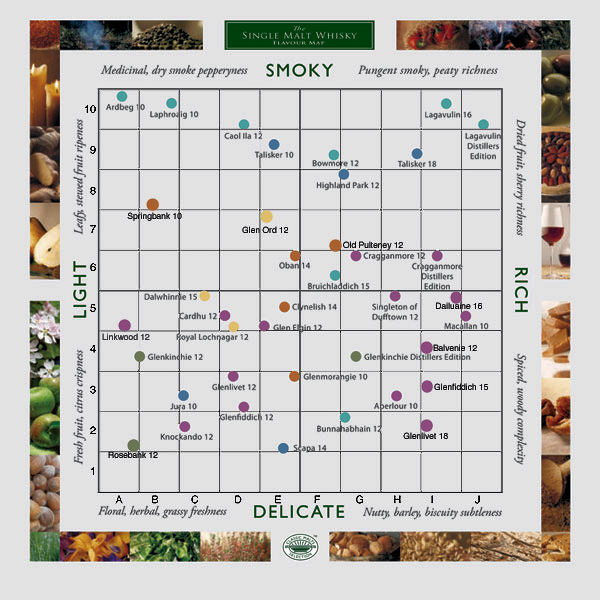
Tasting Whisky
Regional Flavours
As well as giving an accurate account of taste, the Flavour Map also shows where a whisky comes from when used alongside the regional colour map. Simply match a region and whisky by colour to discover local similarities and some intriguing exceptions.
You can now explore further by choosing new whiskies that lie close to personal favourites, or by heading off across the map in an entirely new direction.
Why not do a Whisky Tasting?
This is an experience involving all five senses. And to help compare different whiskies, there are some general steps that can be followed.
What to taste? There are many ways to approach a Scotch Whisky tasting, for example, tasting whiskies of different ages, from different regions, or those matured in different casks. This is all part of the fun and discovery.
A tulip-shaped glass will help to compare different whiskies by trapping the aromas in the bottom and releasing them in the small area at the top of the glass. Whisky is also often enjoyed from a tumbler, particularly if drunk with water or as a long drink. See our Whisky tasting snifter here
Use your eyes ...
Hold up the glass up against a neutral background. What you see is important, as colour can give clues about the age of the whisky and the type of cask used for maturation.
New-make spirit prior to maturation is as clear as water. After years maturing in the cask, however, it can be a much darker colour. The colour comes from the whisky sitting in the cask over years, ebbing and flowing in and out of the wood.
Check the legs ...
Swirl the whisky around the glass, coating its sides thoroughly. Then wait and watch, as the liquid runs back down the side of the glass, the 'legs' of the whisky.
If the 'legs' are thin and run quickly, then it may be a younger or lighter whisky. If the 'legs' are slow and thick, then it may be a heavier or older whisky.
Next the nose ...
Confirm your assumptions and discover more about the dram using your nose. Indeed, a master distiller will use his nose alone to make judgements about a whisky.
Don't worry if it proves difficult to describe the aroma – scientists have discovered a wide range of flavours in whisky and different people will pick up different aromas. With a little practice, it becomes easier.
Add some water ...
After 'nosing' the whisky, try adding a little still water, then use your nose again. The water will reduce the alcohol content, and raises the temperature slightly releasing more of the whisky's flavours – and you will see this happening in your glass.
And now, finally, taste ...
Sip the whisky and allow it to lie on the tongue and coat the sides of your mouth. You might pick out different flavours to those you were aware of using your nose. Roll the spirit around so that it comes into contact with all your taste buds, sweetness at the tip of the tongue, saltiness along the sides, dryness and bitterness at the back.
The wonderful flavours will develop, unfolding in the mouth. Ask yourself what flavours you are experiencing and how the whisky feels in your mouth. Does the flavour last a long time or does it disappear quickly? This is the whisky's finish.
So what did you taste?
Well, there is no right or wrong answer. Everyone and every whisky is different. That is why tasting Scotch Whisky is such an enjoyable and rewarding individual experience.
Also remember that when tasting different whiskies, always do so responsibly. Scotch Whisky is a drink to be sipped and savoured. Have water available – this will cleanse the palate and can be interspersed between trying different whiskies.
View our brief guide to the Whisky regions of Scotland here.












